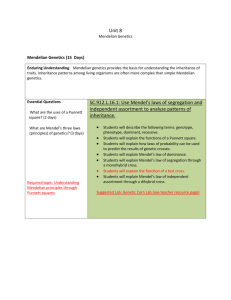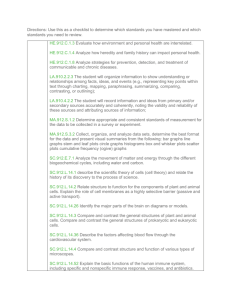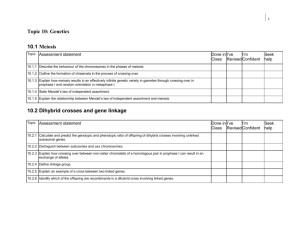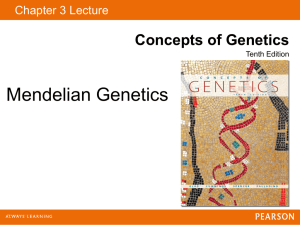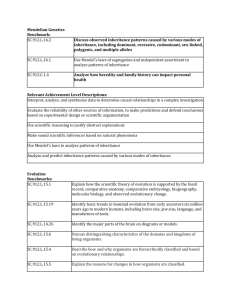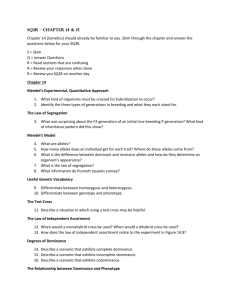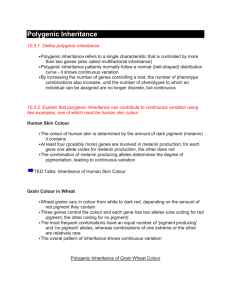Topic 9: Genetics - Jefferson County School District
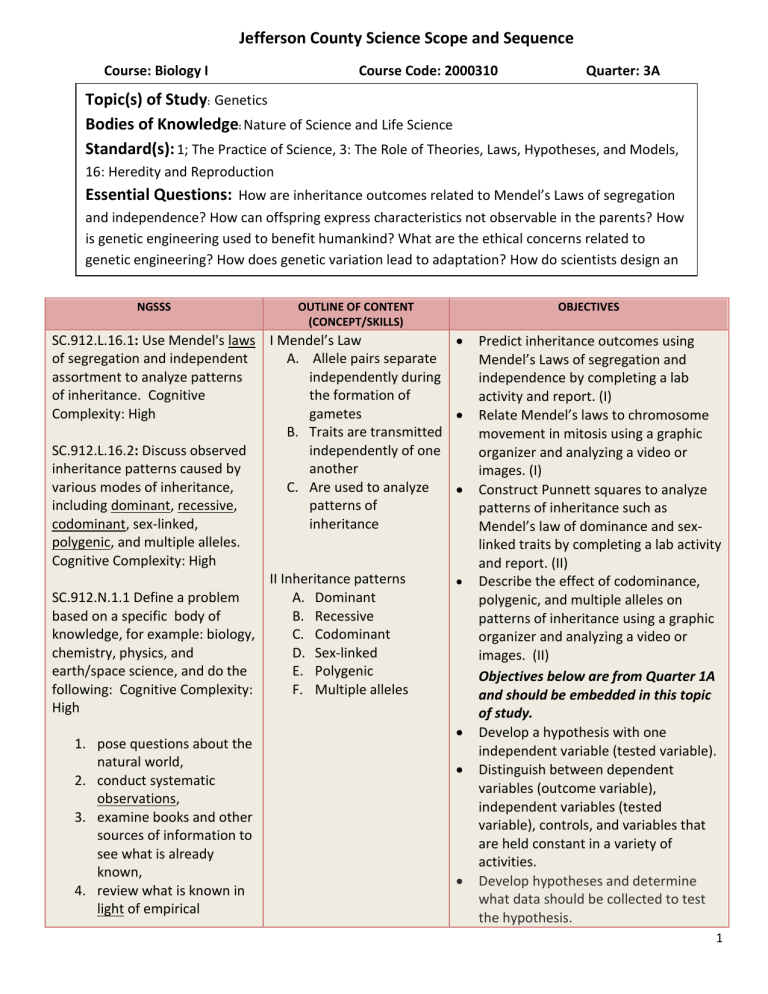
Jefferson County Science Scope and Sequence
Course: Biology I Course Code: 2000310 Quarter: 3A
Topic(s) of Study
:
Genetics
Bodies of Knowledge
:
Nature of Science and Life Science
Standard(s):
1; The Practice of Science, 3: The Role of Theories, Laws, Hypotheses, and Models,
16: Heredity and Reproduction
Essential Questions:
How are inheritance outcomes related to Mendel’s Laws of segregation and independence? How can offspring express characteristics not observable in the parents? How is genetic engineering used to benefit humankind? What are the ethical concerns related to genetic engineering? How does genetic variation lead to adaptation? How do scientists design an investigation to answer a scientific question and communicate their findings?
NGSSS
SC.912.L.16.1: Use Mendel's laws of segregation and independent assortment to analyze patterns of inheritance. Cognitive
Complexity: High
SC.912.L.16.2: Discuss observed inheritance patterns caused by various modes of inheritance, including dominant, recessive, codominant, sex-linked, polygenic, and multiple alleles.
Cognitive Complexity: High
SC.912.N.1.1 Define a problem based on a specific body of knowledge, for example: biology, chemistry, physics, and earth/space science, and do the following: Cognitive Complexity:
High
OUTLINE OF CONTENT
(CONCEPT/SKILLS)
I Mendel’s Law
A.
Allele pairs separate independently during the formation of gametes
B.
Traits are transmitted independently of one another
C.
Are used to analyze patterns of inheritance
II Inheritance patterns
A.
Dominant
B.
Recessive
C.
Codominant
D.
Sex-linked
E.
Polygenic
F.
Multiple alleles
1.
2.
3.
pose questions about the natural world, conduct systematic observations, examine books and other sources of information to see what is already known,
4.
review what is known in light of empirical
OBJECTIVES
Predict inheritance outcomes using
Mendel’s Laws of segregation and independence by completing a lab activity and report. (I)
Relate Mendel’s laws to chromosome movement in mitosis using a graphic organizer and analyzing a video or images. (I)
Construct Punnett squares to analyze patterns of inheritance such as
Mendel’s law of dominance and sexlinked traits by completing a lab activity and report. (II)
Describe the effect of codominance, polygenic, and multiple alleles on patterns of inheritance using a graphic organizer and analyzing a video or images. (II)
Objectives below are from Quarter 1A and should be embedded in this topic of study.
Develop a hypothesis with one independent variable (tested variable).
Distinguish between dependent variables (outcome variable), independent variables (tested variable), controls, and variables that are held constant in a variety of activities.
Develop hypotheses and determine what data should be collected to test the hypothesis.
1
evidence,
5.
plan investigations,
6.
use tools to gather, analyze, and interpret data (this includes the use of measurement in metric and other systems, and also the generation and interpretation of graphical representations of data, including data tables and graphs),
7.
pose answers, explanations, or descriptions of events,
8.
generate explanations that explicate or describe natural phenomena
(inferences),
9.
use appropriate evidence and reasoning to justify these explanations to others,
10.
communicate results of scientific investigations, and
11.
evaluate the merits of the explanations produced by others.
Jefferson County Science Scope and Sequence
Determine tools and methods that should be used to collect valid data.
Determine how data will be collected to analyze the data.
Determine appropriate and consistent standards of measurement for the data to be collected in a survey or experiment.
Collect, organize, and analyze data sets, determine the best format for the data and present visual summaries from the following: bar graphs, line graphs, scatter plots, cumulative frequency graphs.
Distinguish between laws and theories by understanding that laws describe
the what and theories explain the why.
Compare and contrast the terms that describe examples of scientific knowledge such as: theory, law, hypothesis, and model.
SC.912.N.1.3 Recognize that the strength or usefulness of a scientific claim is evaluated through scientific argumentation, which depends on critical and logical thinking, and the active consideration of alternative scientific explanations to explain the data presented. Cognitive
Complexity: Low
SC.912.N.1.4 Identify sources of information and assess their reliability according to the strict standards of scientific
2
Jefferson County Science Scope and Sequence
investigation. Cognitive
Complexity: High
SC.912.N.1.6 Describe how scientific inferences are drawn from scientific observations and provide examples from the content being studied Cognitive
Complexity: Moderate
SC.912.N.3.4 Recognize that theories do not become laws, nor do laws become theories; theories are well supported explanations and laws are well supported descriptions.
Cognitive Complexity: Moderate
LA.910.2.2.3 The student will organize information to show understanding or relationships among facts, ideas, and events (e.g., representing key points within text through charting, mapping, paraphrasing, summarizing, comparing, contrasting, or outlining);
LA.910.4.2.2 The student will record information and ideas from primary and/or secondary sources accurately and coherently, noting the validity and reliability of these sources and attributing sources of information;
MA.912.S.1.2 Determine appropriate and consistent standards of measurement for the data to be collected in a survey or experiment.
MA.912.S.3.2 Collect, organize, and analyze data sets, determine the best format for the data and
3
present visual summaries from the following:
bar graph s
line graphs
stem and leaf plots
circle graph s
histograms
box and whisker plots
scatter plots cumulative frequency (ogive) graphs
Jefferson County Science Scope and Sequence
4
Jefferson County Science Scope and Sequence
5

